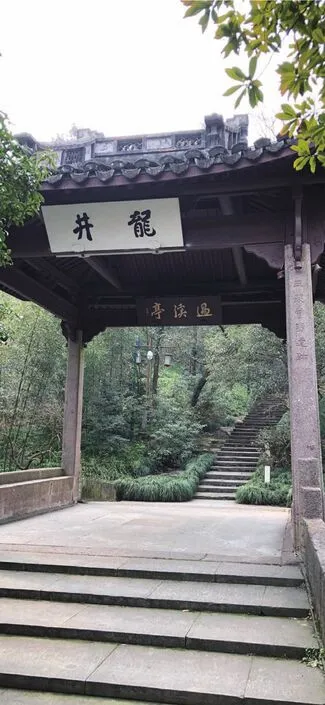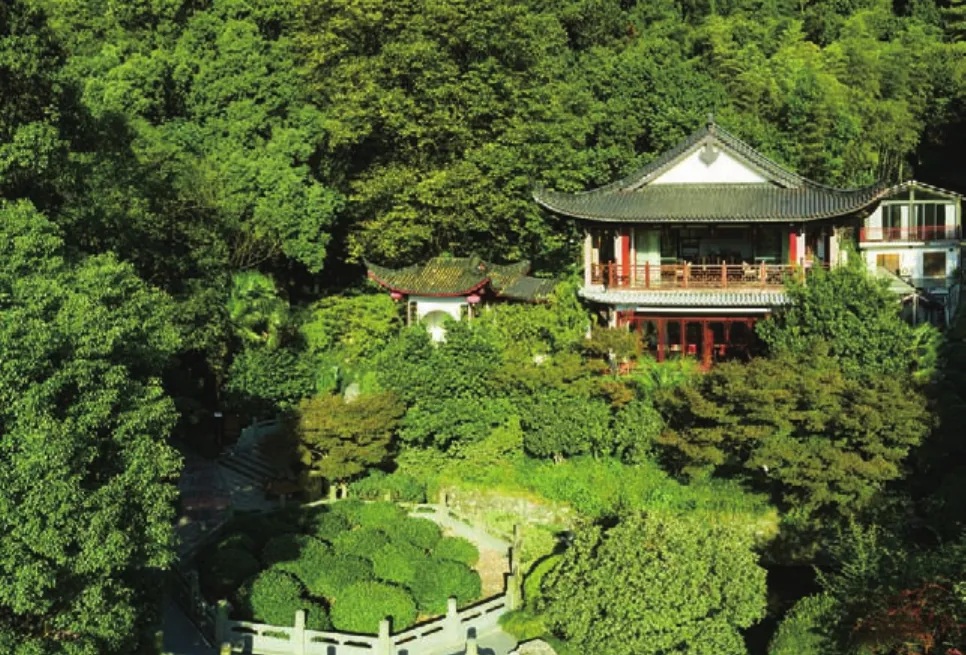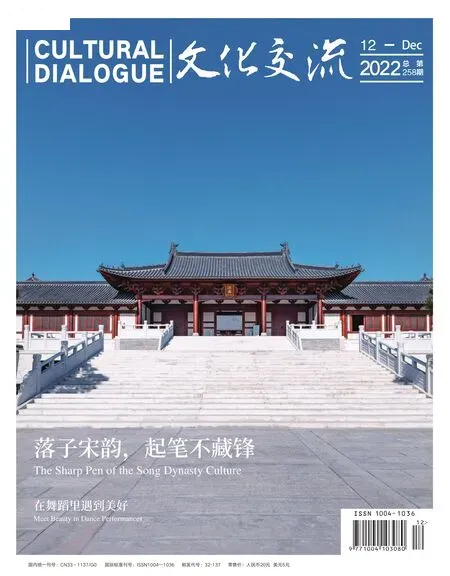辩才法师为苏东坡儿子“摩顶”
文/ 司马一民

苏东坡与辩才石像。Stone statues of Su Dongpo and Biancai.
辩才(1011年—1091年),俗姓徐,名无象,法名元净,号辩才,于潜县(今临安于潜)人。他家乐善好施,经常帮助穷苦之人。相传,在他出生的时候,有位外乡客路过,说他家的房子里有瑞气上升,会出奇男子。刚生下来时,他的左肩上有肉隆起,形状如同袈裟绦,八十一天后才消失,辩才正好是在八十一岁的时候圆寂。
辩才十岁的时候,父母亲把他送到西菩山明智寺出家为僧,师从僧人法雨禅师。辩才天资聪颖,好学精进,博学强记。辩才十八岁离开西菩山明智寺,来到杭州上天竺寺,师从慈云法师,学习天台教义,深得慈云真传,知行并进。慈云圆寂后,又师从明智韶师,学《摩诃止观》。在名师指点下,辩才道行渐高,行化东南,在吴越一带很有名望。辩才二十五岁的时候,宋仁宗闻其德行,特恩赐紫衣袈裟,并赐法号“辩才”。此后,他代明智韶师讲法长达十五年之久,住持大悲宝阁院前后又长达十年之久。
嘉佑末年(1063),杭州知州沈遘以上天竺寺住持智月法师之邀,聘请辩才入山住持,并上请朝廷,以教易禅,朝廷恩准,赐改寺名为“灵感观音院”。吴越信众解囊相助,辩才“开山辟地二十五寻”,“增广殿宇”,“几至万础”,且“殿皆重檐”,“重楼杰观,冠于浙西”,前来求学的僧众越来越多,上天竺因此而成为杭州名刹。辩才在上天竺住持法席十七年。
元丰二年(1079),年届古稀的辩才从上天竺退居南山龙井寿圣院。北宋乾祐二年(949),当地百姓募缘在此建报国看经院,熙宁(1068—1077)中改称寿圣院,即龙井寺。后因年久失修,寺院破败不堪,仅存“蔽屋数楹”。辩才“策杖独往”,“以茅竹自覆”。因辩才修葺屋宇,寺院得到振兴,他最后圆寂于此。
辩才法师不但道行高深,而且颇有诗才。他与同时代的许多诗人因心性相投,友情颇深,时有诗作唱和,给我们留下了他们交往的趣事。这里说说辩才法师与苏东坡的诗作唱和。
辩才法师与苏东坡最为投缘。熙宁四年(1071年)苏东坡到杭州任通判,这是他第一次到杭州,他与辩才法师因缘相识。那年苏东坡34岁,辩才法师已经60岁,二十多年的年龄差距,居然没有违和感,两人结下了忘年交。
当时,苏东坡的第二个儿子苏迨患小儿脑积水症,脑袋病态地特别大,快四岁了还不会走路,苏东坡非常着急。辩才法师知道后,让苏轼带苏迨来见,他为苏迨进行摩顶治疗,很快治好了苏迨的病。

辩才亭。The Biancai Pavilion.
什么是“摩顶治疗”?玄乎。辩才法师究竟用什么医道治好了苏迨的病,也难考据,不过,治好了苏迨的病总是真的,有苏东坡《赠上竺辩才师》诗为证,其中就有这么几句:“我有长头儿,角颊峙犀玉。四岁不知行,抱负烦背腹。师来为摩顶,起走趁奔鹿。”
这是一首纪事诗,诗中苏东坡描绘了辩才法师的形象,飘飘若仙的样子 ;描绘了辩才法师的医道,神奇的治病过程 ;描绘了苏迨的病状以及病愈后的活泼。
元祐四年(1089年),离开杭州十五年后,苏东坡重回杭州任知州,此时年迈的辩才已从上天竺寺退居龙井寺,苏东坡即去拜访。苏东坡来访,辩才十分欣喜,最难风雨故人来,两人经常茶叙清谈。
有一天,苏东坡去龙井寺见辩才法师,晚间茶叙,突然雷电交加,暴雨疾至,窗前有两棵松树的树枝被吹折。辩才法师触景生情,脱口吟出一联:“龙枝已逐风雷变,减却虚窗半日凉”。苏东坡应声吟出:“天爱禅心圆且洁,故添明月伴清光”。僧、俗两人如此心性相通,亘古未见。
辩才法师退居龙井寺后,慕名而来的客人仍然很多,年迈之人受不了打搅,不得已定了个规矩:待客不超三炷香,送客不过归隐桥。
元祐六年(1091年),苏东坡被朝廷召回。离杭前,苏东坡去龙井寺拜别辩才法师,两人相谈甚欢,不觉已经月上柳梢,辩才法师留苏东坡夜宿龙井寺。第二天一早,辩才法师送苏东坡下山,一路谈笑,不知不觉过了溪上的归隐桥。小沙弥连忙提醒辩才法师破了规矩,辩才法师与苏东坡停下脚步,相顾大笑。辩才法师吟诵了杜子美的诗:“与子成二老,来往亦风流。”
辩才有《龙井新亭初成诗呈府帅苏翰林》纪事,说的是苏东坡在处理完公务以后,经常去龙井寺,二人“路穿乱石脚”,走遍了龙井的山山水水;“煮茗款道论”,虽然二人论什么道,我们不得而知,但是能与苏东坡经常“道论”的人,必定旗鼓相当;“声光千载留”,二人的风采当与龙井的山水一样留存千古;最后两句“愿公归庙堂,用慰天下忧”,期望苏东坡这位济世之才早日回归朝廷,能为普天下百姓解忧,也就是说杭州这片土地太小,苏东坡应该立身于朝廷造福天下。
苏东坡也有诗相和,其中有几句这样写道:“送我还过溪,溪水当逆流。聊使此山人,永记二老游。大千在掌握,宁有别离忧。”
这真是一段千古佳话。后来,辩才法师在老龙井旁建了“过溪亭”,于是龙井又多了一景。后人把辩才法师送苏东坡过溪经过的归隐桥,称之为“二老桥”。
元祐六年(1091年)秋天,辩才法师自知来日无多,就入室端坐,谢绝宾客,不再言语、饮食。到第五日,辩才法师以偈语作别众人。到了第七日,法师安然圆寂。

龙井过溪亭。The Guoxi Pavilion at Longjing village in Hangzhou.
第二年五月,辩才法师的徒弟惟楚携带一轴当年苏东坡给辩才法师的信,去扬州找在那里任知州的苏东坡,请求题跋。苏东坡立即写题跋并作偈祭奠:“虽大法师,自戒定通。律无持破,垢净皆空。讲无辨讷,事理皆融。如不动山,如常撞钟。如一月水,如万窍风。八十一年,生虽有终。遇物而应,施则无穷。”这年十月,辩才法师骨塔在龙井狮峰山麓建成,苏东坡请弟弟苏辙撰写辨才大师的塔碑铭文,以作纪念。
Master Biancai Curing Son of Su Dongpo
By Sima Yimin
Popularly known as Biancai (1011-1091) or Master Dharma Debater, a title bestowed by Emperor Renzong of Song (1010-1063), the master monk was born in Yuqian county (present-day Yuqian township, Lin’an district, Hangzhou city) in the year 1101.The original name of Biancai, who went by the dharma name Yuanjing, was Xu Wuxiang.
The Xu family was recognized as being very generous and compassionate, regularly doling out food and money to those who were in need. Legend has it that on the day when Biancai was born, a visitor passing by the Xu family pointed at their house and declared that an auspicious light was rising, portending to the birth of an extraordinary man. After he was born, a strip of bulge could be seen on Biancai’s left shoulder, quite like the silk linings on kasaya (robes worn by Buddhist monks). The bulge disappeared after 81 days; coincidently, Biaocai also died when he was 81 years old (1091), a number that holds special significance for Buddhists.
When he was 10 years old, Biancai was sent by his parents sent to Yuqian’s Mingzhi Temple on the Xipu Mountain, where he obtained his dharma name Yuanjing. As a smart and hardworking student, Biancai benefited a lot through learning from several Buddhist masters in several different temples. Gradually, Biancai established his reputation. By the time when he turned 25,Biancai’s name traveled so far and wide that the reigning emperor,Emperor Renzong of Song, after hearing of his moral integrity,bestowed upon him the title of “Biancai” and the purple kasaya,the color of the highest honor for a Buddhist monk.
Noted not only for his wisdom and mastery of Buddhist knowledge and practices, Biancai was also celebrated for his literary exploits, especially poetry. In fact, he counted Su Shi (1037-1101),Qin Guan (1049-1100), Huang Tingjian (1045-1105), and other prominent literary figures of his time among his close friends.
Su Shi, aka Su Dongpo, was perhaps Biancai’s best poet friend. In 1071, when Sufirst came to Hangzhou and served as its controller-general, he got to know Master Biancai by chance.Despite their age difference - Su was 34 years old and Biancai was already 60 at the time, the two soon became bosom friends.
It so happened that Su Dai, Su Dongpo’s second son, was suffering from infantile hydrocephalus. At about four years old, Su Dai’s head was morbidly large, and he still could not walk. When Biancai learned about it, he asked Su Shi to bring his son to see him. What did Biancai do? He administered the so-called “mo dingtreatment” for Su Dai, who soon returned to normal.
So what is “mo dingtreatment”? In Buddhist practices,mo dingliterally means “laying the hand on the top of the head, and it originally refers to a custom of Buddha teaching his disciples, from which the burning of the spots on the head of a monk is said to have originated.
Did the practice really have such mystic powers? Or did Biancai in fact know a thing or two about medicine and he cured Su Dai through his medical knowledge? It is hard to tell, as there is no documents or records available to verify what had transpired.
Apparently, Biancai did lay his hand on the head of Su Dai, as attested by a poem Su Shi later composed; and apparently, Su Dai speedily recovered afterwards, as described in the same poem.
In 1089, 15 years after Su Shi left Hangzhou, he returned to the place to serve as its prefect. Among the first things that Su did was to visit Biancai. In 1091, Su and Biancai met for the last time before the former was transferred to the capital. Later that year,Master Biancai passed away peacefully.

十八棵茶树。肖奕叁/摄18 tea plants. Photo by Xiao Yisan.

